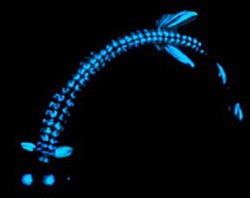Bioluminescence in the Deep Sea
Biology 342 Fall 2010
Author: Esther Ladizinsky
Ontogeny
Ontogeny is concerned not only with the development of behavior, but the factors affecting that development, particularly those with genetic bases versus environmental. When applying these questions to bioluinescence, it is imperative to distinguish whether we're talking about luminous animals or animals utilizing a luminous symbiont bacteria.
Symbiotic Bacteria
Though it seems strange to imagine a bacterial colony developing in conjunction with its symbiotic host, that appears to be the case... at least for Photobacterium leiognathi and Nuchequula nuchalis, a marine fish. In an experiment measuring the presence of different strains of P. leiognathi (some luminous, some not) in the light organs of fish at larval and adult stages, Nuchequula nuchalis at its smallest stage (6-6.5mm in notochord length, the developmental point at which the light organ has not yet established interface with the nacent gasbladder) had virtually no bacteria present in its light organ, while specimens of notochord length >6.5 had P. leiognathi in abundance. However, juveniles' P. leiognathi populations had a far smaller proportion of luminous strains (79 to 249) than adults' (75 to 91); that is to say, even though the bacteria was present, juveniles still did not luminesce as vibrantly as adults(1).
Inherent Luminescence
Like any other organ, the light organs responsible for giving independently luminous animals their glow would appear to develop in the embryonic stage. These observations were made in studying the ontogeny of a common Atlantic deep-dweller, the velvet belly lantern shark (2): as these organs mature, the cells that make them up develop luminescent vesicles, and the body area that they occupy increases greatly; indeed, it seems as though animals that bioluminesce on their own can do so even before birth!